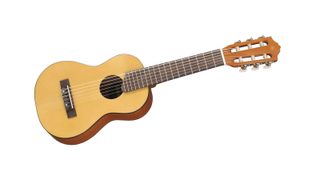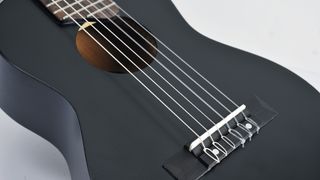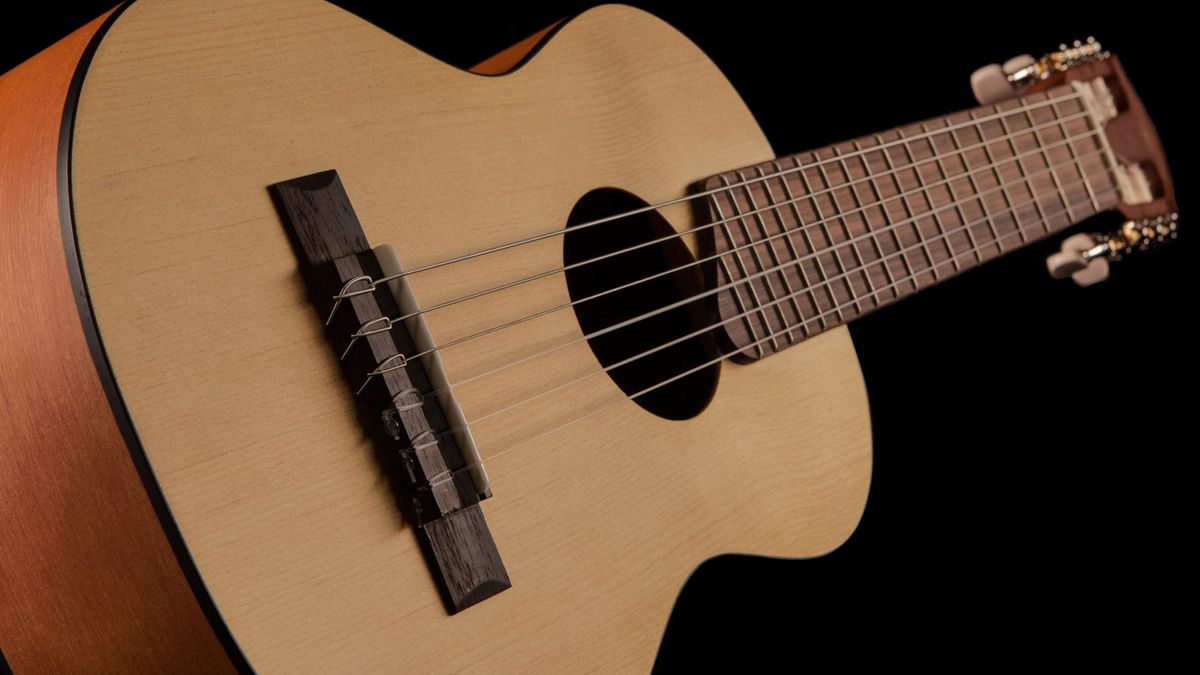MusicRadar Verdict
The GL-1 is a fun instrument but it's no joke. Ideal for travel and practicing, it's more versatile than a ukulele and sounds richer too.
Pros
- +
Price
- +
Versatility
- +
Build quality
- +
It's not a ukulele
Cons
- -
Tuning not for everyone
- -
Cramped fingerboard
- -
It's not a ukulele
MusicRadar's got your back
Yamaha Guitalele GL-1 review: What is it?
As cute as a labradoodle puppy, as practical as a mule and with a name as daft as a zonkey, at first glance it's hard to see where the Yamaha Guitalele GL1 fits in. A mad guitar/ukulele mutation, it’s neither here nor there, not one thing or another.
But somehow, like the labradoodle, it makes sense. I dare anyone to pick one of these things up without breaking into laughter or attempting to play a simple tune. It's just tremendous fun.
So, how do you pronounce Guitalele? In truth, we're not sure but some people insert an 'r' or a double 'h' sound in the middle – Guitahh-lele. We're musicians, not linguists, so in public we take the coward's way out and refer to it simply as the GL1, which works for us.
Despite its name, and the similarities in size, in terms of construction the Guitalele is far more classical guitar-like than ukulele. Like a uke, nylon strings are the order of the day (it's not strong enough for steel strings, so please don't try), but there are six of them versus the ukulele's four, and they're tensioned with decorative, classical-style side-mounted machine heads.
Most ukes get a big part of their characteristic sound from 'reentrant tuning', which means that the third string is the bass string, often C, and the fourth string (the one nearest your chin) is tuned a fifth up to G. As you can imagine, playing the uke is like learning a whole new instrument whereas, for guitar players at least, playing the Guitalele is just like playing the guitar, albeit one made in Lilliput.
Size aside, the significant difference between the guitar and the Guitalele is its ADGCEA tuning, which is entirely due to its short 433mm (17") scale length. Fortunately, these tunings share the same intervals as the guitar so, in effect, it's like playing a guitar at the fifth fret. If you're moving from a guitar to a Guitalele you'll get used to it very quickly. If you're moving from a ukulele to a Guitalele it will still feel somewhat familiar because the top four strings share the same notes – GCEA but with the G tuned up as previously explained.

Top end Yamaha acoustics are handmade in its Hamamatsu custom shop in Japan, where a small team of master luthiers spend most of their lives endlessly tapping bits of wood to ascertain their acoustic characteristics. It's safe to assume that no Guitalele has ever been near the Hamamatsu workshop, let alone been tapped by a master luthier, but the build quality is remarkably good for a sub $/£100 instrument.
They're actually made in Yamaha's own Indonesian factory. Tops are spruce, while back and sides are made from meranti, a locally sourced tonewood with similar characteristics to mahogany. The neck is also meranti, with a rosewood fingerboard. Visually, the quality of the woods on our example is excellent, with even grain and no knots or blemishes.
Workmanship is very tidy too, with no lumps, cracks or gaps to be found anywhere. Even the kerfed linings are free of glue remnants. The finish across the entire instrument is matt, which looks classy enough, if a little plain on our Natural version, but if you want to make more of a visual splash then you can choose from Persimmon Brown, Tobacco Brown Sunburst and Black. Care has obviously been taken to apply the finish as thinly and evenly as possible, so as not to swamp or dampen the sound.
Yamaha Guitalele GL-1 review: Performance & verdict

Playability is surprising. The action on our example is slightly on the high side, but then this is a nylon-stringed instrument. Frets are even, with no sharp edges, the nut material is clearly cheap, but the slots are well cut. Intonation is spot on too, no doubt helped by the compensated saddle.
The 48mm (1 7/8") nut width is generous enough for most fingers, after all many Strats come in at way less than this. However, the Guitalele's scale length does dramatically shorten the distance between the frets, which can make playing a bit cramped. If you're used to playing down the 'dusty end' of a regular guitar then you'll be fine, but if not it may take a bit of getting used to.
It's zingy and jangly, like a good uke, but its classical roots – notably those bass strings – endow it with more warmth and depth
So, does it sound like a musical instrument or a cheap novelty plaything? In its favour, the Guitalele is lightly built and subsequently beautifully resonant. If your ideal tone is that of a fine cedar-topped classical guitar then you'll be disappointed, but reframe your expectations and you'll discover the Guitalele has a charm all of its own.
It's zingy and jangly, like a good uke, but its classical roots – notably those bass strings – endow it with more warmth and depth. Strum it for any length of time and, just like a uke, the tone can eventually become irritating (sorry, uke players) but it responds really well to classical or fingerstyle pieces. With the right composition, it can sound almost lute-like – in a good way!
This is where the Guitalele scores over a ukulele, and I fully appreciate we're comparing apples with oranges here. It can tackle a much broader repertoire, and it can cope, if not excel, with a wider range of musical styles.
The Guitalele is a fun instrument for fun times. It's crying out to be left on the sofa, ready to be played on a whim. It's pleading to be taken out on camping trips, so it can accompany your drunk mates. Like any loveable mongrel, it just wants to be friends.
Yamaha Guitalele GL-1 review: Hands-on demos
YourGuitarSage
Rimmers Music
Yamaha Guitalele GL-1 review: Specifications
- Scale Length: 433mm (17")
- Body Length: 319mm (12 9/16")
- Total Length: 698mm (27 1/2")
- Body Width: 229mm (9")
- Body Depth: 70mm (2 3/4")
- Nut Width: 48mm (1 7/8")
- Top Material: Spruce
- Back/Side/Neck Material: Meranti
- Fingerboard Material: Rosewood
- Fingerboard Radius: Flat
- Bridge Material: Maple
- Nut and Saddle Material: Urea
- Tuners: Chrome, side-mounted
- Body Binding: Black
- Body And Neck Finish: Matt
- Strings: Nylon
- Gig Bag Included: Yes
- Contact: Yamaha
When Simon's childhood classical guitar teacher boasted he 'enjoyed a challenge', the poor man had no idea how much he'd underestimated the scale of the task ahead. Despite Simon's lack of talent, the experience did spark a lifelong passion for music. His classical guitar was discarded for an electric, then a room full of electrics before Simon discovered the joys of keys. Against all odds, Simon somehow managed to blag a career as a fashion journalist, but he's now more suitably employed writing for MusicRadar and Guitar World. When not writing or playing, he can be found terrifying himself on his mountain bike.

“Inspired by the popular Iron Label series, these instruments feature an all-black aesthetic, including a matte black finish and black hardware”: These new Ibanez Blackout acoustic guitars are… kinda metal looking

“Definitely one of the most unique pieces to come through our showroom”: It was left in a nightclub in '74, then “hidden in a closet for decades”, now Mike Bloomfield’s custom-painted 1966 Telecaster is up for sale

NAMM 2025: Latest news, rumours and updates - “Based on the latest information, the 2025 NAMM Show will be able to take place,” say organisers
Most Popular











